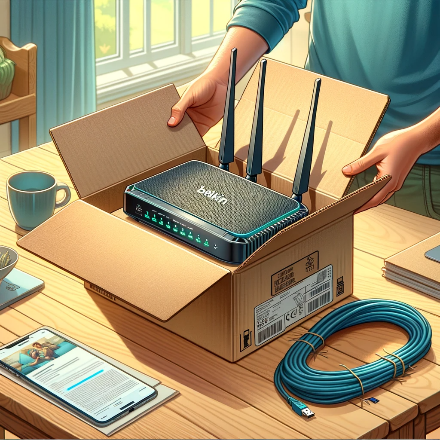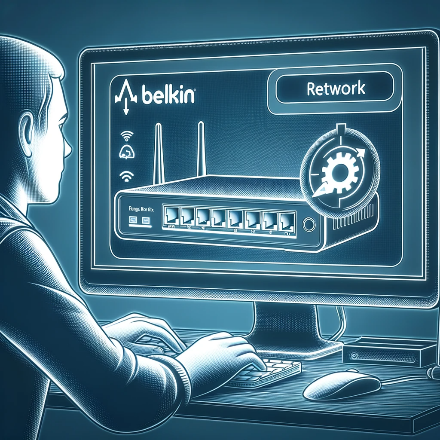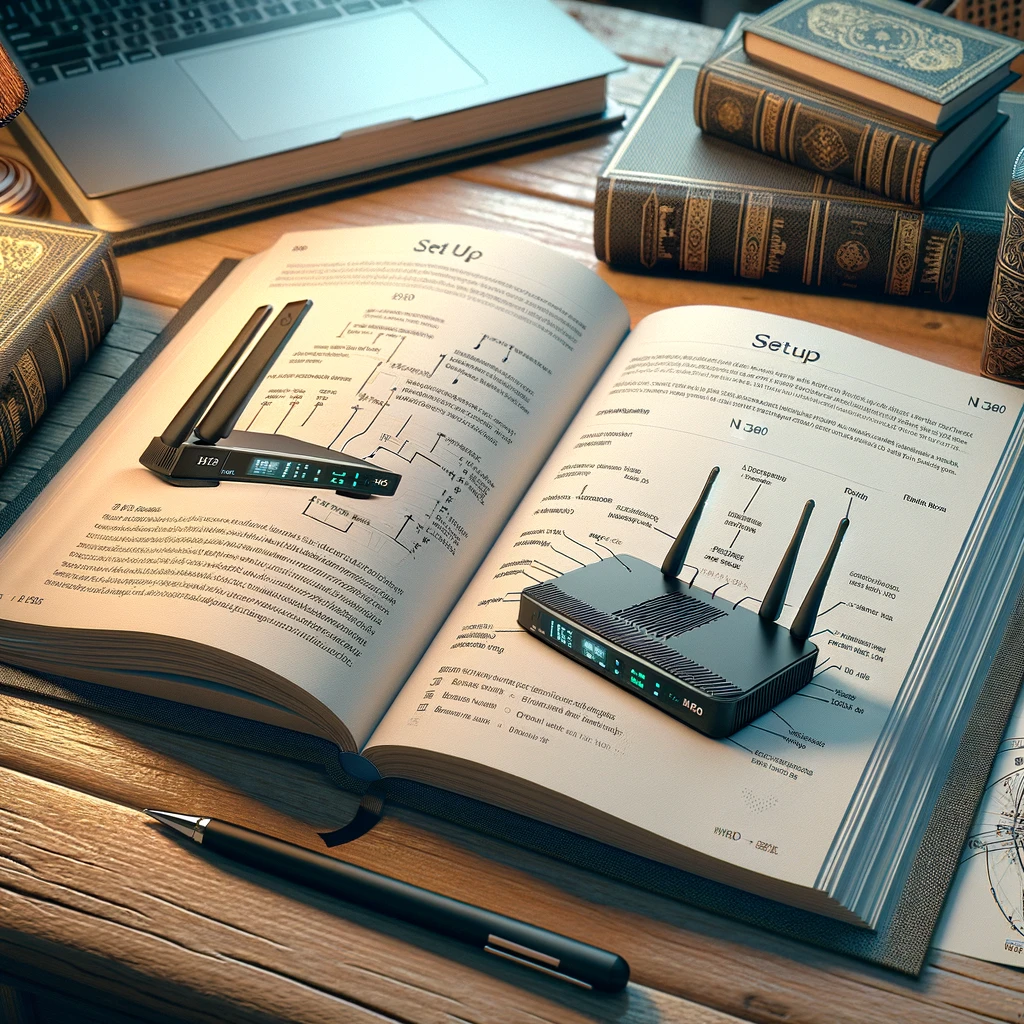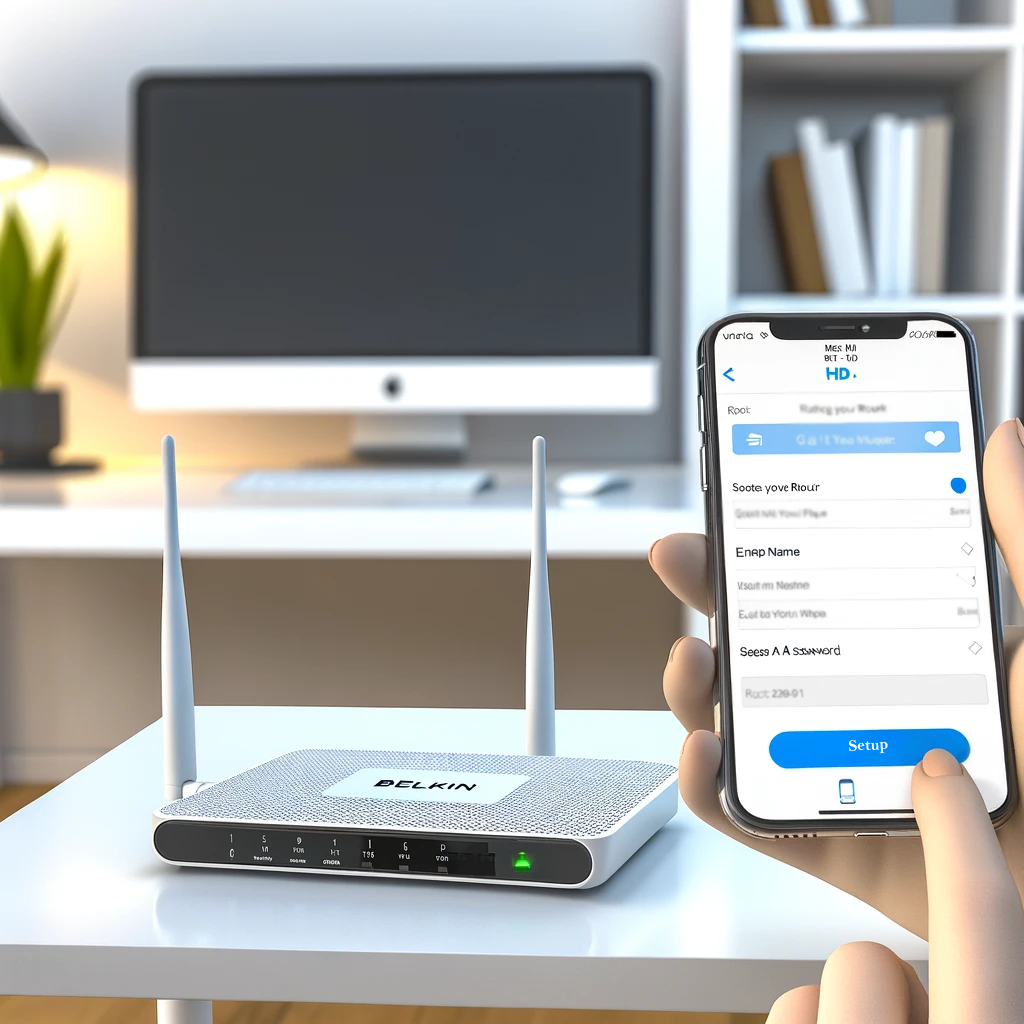Belkin Router Setup
Welcome to the comprehensive guide on belkin setup. Setting up your Belkin router correctly is crucial for establishing a strong and reliable home network. Whether you’re a first-time user or looking to upgrade your current setup, this guide will walk you through the essential steps to get your Belkin router up and running efficiently.
The Importance of Proper Belkin Router Installation
A successful belkin setup is key to ensuring your home network’s optimal performance. With the right setup, your Belkin router will provide seamless internet connectivity, essential for everything from daily browsing to streaming and gaming. Proper installation is not just about physical setup; it also involves configuring your router to suit your specific network needs and security requirements.
General Steps in Belkin Router Setup:
To kick off your belkin setup, you’ll need to follow some general steps. These include:
-
Unboxing and Connecting Your Belkin Router:
Start by unboxing your Belkin router and connecting it to your modem. This is the first physical step in the belkin setup process.
-
Powering On:
Once connected, power on your router and wait for it to boot up. This is a crucial step in the belkin setup as it prepares your device for configuration.
-
Accessing the Belkin Router’s Interface:
Next in your belkin setup, you will access the router’s web interface through a computer or smartphone. This is where the bulk of your configuration will take place.
-
Basic Configuration:
During your belkin setup, you’ll configure basic settings such as network name (SSID), password, and internet connection type.
-
Finalizing Setup:
Conclude your belkin setup by saving your settings and ensuring that all your devices can connect to the network seamlessly.
In the following sections, we will delve into each of these steps in detail, ensuring your belkin setup is smooth and hassle-free. Whether you’re setting up a new router or reconfiguring an existing one, this guide will provide all the necessary instructions for a successful Belkin router setup.
Step-by-Step Guide to Belkin Router Setup
Embarking on your belkin router setup journey can be straightforward if you follow these detailed steps. From initial hardware connections to basic configurations, this guide ensures that your belkin router setup process is smooth and effective.
Initial Hardware Connections for Belkin Router
-
Unboxing and Positioning:
Begin your belkin router setup by unboxing your router and placing it in a central location. This ensures optimal signal distribution for your network.
-
Connecting to the Modem:
Connect your Belkin router to your internet modem using an Ethernet cable. This is a vital step in your belkin router setup as it forms the backbone of your network connection.
-
Powering On Your Belkin Router:
Plug in your router to a power source and switch it on. Watch for the indicator lights to confirm that your router is functioning correctly, a crucial check in the belkin router setup.
Accessing the Belkin Router’s Interface
-
Connecting to the Network:
On your computer or smartphone, connect to the Belkin router’s network. This could be a wired or wireless connection, depending on your setup preferences in the belkin router setup.
-
Navigating to the Web Interface:
Open your web browser and enter the router’s IP address, typically found in the manual. This step in the belkin router setup is essential for accessing the configuration settings.
Basic Configuration Settings
-
Setting Up Network Credentials:
As part of your belkin router setup, you’ll configure your wireless network’s name (SSID) and password. This ensures your network is easily identifiable and secure.
-
Configuring Internet Settings:
Choose your connection type (such as DHCP, PPPoE) based on your ISP’s requirements. This customization is a significant aspect of the configure belkin router process.
-
Updating Belkin Router Firmware:
Check for any available firmware updates. Updating your router’s firmware during the belkin router setup can enhance performance and security.
-
Enabling Network Security Features:
Ensure that security features like WPA2 encryption are enabled. This is a critical step in the configure belkin router process for safeguarding your network.
-
Saving and Testing Settings:
After configuring your settings, save them and perform a test to ensure everything is functioning correctly. This marks the successful completion of your belkin router setup.
You have now completed the essential steps of the belkin router setup. The process of configure belkin router can be simple and rewarding, ensuring a robust and secure home network. Remember, each step is crucial for the overall performance and security of your network.
Model-Specific Setup Guides for Belkin Wireless Routers
Tailored Setup Guides for Belkin N300 and N600 Models
In this section, we focus on the belkin wireless router setup for two popular models: the Belkin N300 and N600. While the overall process of belkin wireless router setup is similar across models, there are specific nuances and steps unique to each that we will cover here.
Belkin N300 Setup
Setting Up Your Belkin N300 Router
-
Unpacking and Connectivity:
Start your belkin n300 setup by unboxing the router and connecting it to your modem. This initial step is critical for a smooth belkin wireless router setup.
-
Power and Initial Configuration:
Power on your N300 router. The setup wizard should launch automatically, guiding you through the belkin n300 setup process.
-
Customizing Network Settings:
Customize your SSID and password during the belkin n300 setup. This is a crucial step to ensure your network is secure and easily identifiable.
-
Finalizing the Belkin N300 Setup:
After configuring your settings, ensure all devices can connect to the N300 network. This step confirms the successful belkin n300 setup.
Belkin N600 Setup
Setting Up Your Belkin N600 Router
-
Initial Belkin Router Connection:
In your belkin n600 setup, connect the router to your modem. This step is fundamental to the overall belkin wireless router setup.
-
Activating the Belkin Router:
Turn on your N600 router. You should see a setup page prompting you to begin the belkin n600 setup.
-
Network Configuration:
As part of your belkin n600 setup, configure your wireless network name and password. It’s essential for the security and personalization of your network.
-
Completing the Belkin N600 Setup:
Test your network to ensure all devices are connected and operating correctly, marking the completion of your belkin n600 setup.
Whether you are conducting a belkin n300 setup or a belkin n600 setup, each model requires specific steps within the broader belkin wireless router setup process. By following these model-specific guidelines, you can ensure a successful setup, tailored to the unique features and functionalities of your Belkin router model.
Advanced Configuration Settings for Belkin Routers
After completing the basic setup of your Belkin router, it’s time to delve into more advanced configurations. This section will guide you through the process to configure belkin router for additional features like parental controls, guest networks, and enhanced security settings.
Implementing Parental Controls
-
Accessing Parental Control Settings:
To begin customizing parental controls, access your router’s dashboard by logging in. This is a critical part of the configure belkin router process for family-friendly network management.
-
Setting Up Restrictions:
Within the parental controls section, you can set specific website restrictions or schedule internet access times. This flexibility is a key advantage of the configure belkin router approach for family networks.
Establishing Guest Networks
-
Creating a Guest Network:
A guest network allows visitors to access the internet without compromising your main network’s security. This is an integral feature in advanced configuration settings for belkin routers.
-
Configuring Guest Network Settings:
Customize your guest network’s name and password. This feature in the configure belkin router process ensures a secure yet accessible network for your guests.
Enhancing Belkin Router Security
-
Updating Firmware Regularly:
Regular firmware updates are crucial for security. Accessing the update section in your router’s interface is a vital step to configure belkin router for optimal performance and security.
-
Enabling Advanced Security Features:
Utilize advanced features like WPA3 encryption and firewall settings. These features are central to advanced configuration settings for belkin routers, providing robust protection against cyber threats.
-
Setting Up VPN Support:
If your router supports it, setting up VPN services can significantly enhance network security. This setup is part of the configure belkin router strategy for users needing advanced security measures.
Customizing Network Performance
-
Adjusting Quality of Service (QoS) Settings:
Prioritize bandwidth for critical applications or devices. Adjusting QoS is a nuanced aspect of the configure belkin router process for optimized network performance.
-
Monitoring Network Traffic:
Use built-in tools to monitor your network’s traffic and usage patterns. Understanding these patterns is key to advanced configuration settings for belkin routers.
By exploring these advanced configuration options, you can significantly enhance the functionality and security of your Belkin router. The process to configure belkin router for these settings may seem complex, but it provides a level of customization and control that is invaluable for managing a modern, secure, and efficient home network.
Setting Up Your Belkin Router with a Smartphone for High-Speed Internet
Streamlining Belkin Router Setup Using Your Smartphone
In today’s mobile-driven world, setting up your Belkin router using a smartphone is not just convenient but also efficient. This section focuses on the belkin router setup with smartphone, ensuring you can enjoy high-speed internet without the need for traditional computer-based setup methods.
Preparing for Smartphone-Based Setup
-
Downloading the Belkin Mobile App:
Begin your belkin router setup with smartphone by downloading the official Belkin mobile app. This app is designed to streamline the setup process and offers an intuitive interface for setting up belkin router for high-speed internet.
-
Connecting to the Belkin Router’s Network:
Power on your Belkin router and connect your smartphone to the router’s default Wi-Fi network. This connection is the first step in the belkin router setup with smartphone.
Using the App for Belkin Router Configuration
-
Launching the Setup Wizard:
Open the Belkin app and use the setup wizard. This tool is a key component in the belkin router setup with smartphone, guiding you through the necessary steps.
-
Selecting Internet Connection Type:
Choose your internet connection type within the app. This selection is critical for setting up belkin router for high-speed internet, as it determines how your router communicates with your ISP.
-
Configuring Network Settings:
Set your network’s name (SSID) and password using the app. This step in the belkin router setup with smartphone is essential for securing and personalizing your Wi-Fi network.
Optimizing for High-Speed Internet
-
Adjusting Advanced Settings:
Utilize the app to adjust settings like bandwidth and channel selection, optimizing your router for high-speed internet. This adjustment is an advanced part of the belkin router setup with smartphone.
-
Testing Internet Speed:
After configuration, use the app or a third-party speed test tool to check your internet speed. This test is crucial in confirming the success of your setting up belkin router for high-speed internet.
Maintaining and Monitoring Your Network
-
Regular Firmware Updates:
Use the app to check and install router firmware updates. Keeping your router updated is an integral part of the belkin router setup with smartphone for long-term performance.
-
Monitoring Network Usage:
The app may offer features to monitor data usage and connected devices, an important aspect of managing your belkin router setup with smartphone.
By following these steps, you can effectively complete your belkin router setup with smartphone, ensuring a seamless and efficient process for establishing a high-speed internet connection. This mobile-centric approach aligns with modern technology trends and offers a user-friendly alternative to traditional setup methods.
Troubleshooting Belkin Router Setup Issues: A Step-by-Step Guide
Resolving Common Setup Challenges with Your Belkin Router
Even with careful following of setup instructions, you may encounter issues with your Belkin router. This section is dedicated to troubleshooting belkin router setup issues, offering a step-by-step approach to resolve common challenges and ensure a smooth belkin router configuration.
Identifying and Solving Connectivity Issues
-
No Internet Connection:
If you’re facing connectivity issues post-setup, start by checking the physical connections. Ensure all cables are securely connected. This is a basic yet essential step in troubleshooting belkin router setup issues.
-
Belkin Router Not Broadcasting Wi-Fi:
Ensure your router is powered on and the Wi-Fi LED is lit. If not, restart your router as a first step in troubleshooting belkin router setup issues.
-
Inconsistent or Slow Internet Speed:
Test the internet speed directly from the modem to isolate the issue. If the speed improves when connected to the modem, the router settings might need adjustment—a common aspect of belkin router configuration.
Addressing Belkin Router Configuration Problems
-
Difficulty Accessing Belkin Router Settings:
Ensure you’re using the correct IP address to access the router’s web interface. Incorrect IP addresses are a frequent hurdle in step by step belkin router configuration.
-
Resetting Belkin Router to Factory Defaults:
If configuration changes don’t resolve the issue, consider resetting the router. This can be a crucial step in troubleshooting belkin router setup issues, as it reverts the device to default settings, allowing you to restart the configuration process.
-
Updating Firmware:
Outdated firmware can lead to various issues. Check for updates in the router settings as part of your belkin router configuration.
Frequently Asked Questions (FAQs) About Belkin Router Setup
How do I start the initial belkin setup for my new router?
- Begin by connecting your Belkin router to your modem using an Ethernet cable, then power on the router and connect to its network from your device to access the setup interface.
What are the basic steps for belkin router setup using a computer?
- Connect the router to your modem, power it up, access the router’s web interface via a browser using the router’s IP address, and follow the on-screen instructions for basic configuration.
Can I complete belkin wireless router setup using my smartphone?
- Yes, download the Belkin mobile app, connect to the router’s Wi-Fi network, and use the app to configure your wireless settings.
What should I do if I encounter issues during configure belkin router?
- Verify all physical connections, restart your router, and ensure you’re using the correct settings. If issues persist, reset the router to factory settings and try again.
How do I configure belkin router for parental controls?
- Log into the router’s interface, navigate to the parental controls section, and set up restrictions such as website blocking or access schedules.
Is it possible to set up a guest network during belkin wireless router setup?
- Yes, during the setup process, you can configure a separate guest network with its own SSID and password for visitor use.
What are the common troubleshooting steps for belkin router setup?
- Common steps include checking cable connections, restarting the router, checking for firmware updates, and resetting the router if necessary.
During belkin setup, how can I ensure my router’s security?
- Use strong, unique passwords for both router access and Wi-Fi networks, enable WPA2/WPA3 encryption, and regularly update the router’s firmware.
What is the best way to improve Wi-Fi speed after belkin router setup?
- Position your router centrally, minimize obstructions, use the least congested Wi-Fi channel, and ensure the router’s firmware is up-to-date.
Can I change my Wi-Fi network name and password after completing the belkin wireless router setup?
- Yes, log into your router’s dashboard and navigate to the wireless settings section to update your network’s name (SSID) and password.
Conclusion on Belkin router setup
As we wrap up this comprehensive guide on belkin setup and belkin router setup, it’s important to reflect on the key points and benefits of properly installing and configuring your Belkin router. This guide has covered everything from the initial belkin wireless router setup to advanced configuration tips, ensuring your home network’s efficiency and security.
Emphasizing the Importance of Correct Setup
-
Foundation of a Reliable Network:
Remember, a proper belkin setup is the cornerstone of a robust and dependable home network. By following the steps outlined in this guide, you’ve laid the groundwork for uninterrupted internet access and optimal network performance.
-
Customization and Security:
Through configure belkin router steps, you’ve learned how to tailor your network to your specific needs, from setting up guest networks to implementing advanced security measures. These configurations go beyond basic belkin router setup, offering you a network that is not only fast but also secure.
Continuous Learning and Adaptation
-
Staying Updated:
The world of technology is ever-evolving. Keep yourself informed about new features and updates to your Belkin router. Regular updates and continuous learning are key components of an effective belkin wireless router setup.
-
Seeking Assistance When Needed:
If you encounter difficulties or uncertainties during your belkin setup, don’t hesitate to seek help from official Belkin support channels. A well-informed approach to belkin router setup ensures you get the most out of your device.
The Reward of Persistence and Patience
-
Achieving Optimal Network Performance:
By meticulously following each step for belkin setup and configure belkin router, you’ve positioned your network for optimal performance. The time and effort invested in this process are invaluable in achieving a stable and fast internet connection.
-
Enjoying the Benefits of a Well-Set-Up Router:
As a result of your diligent work in belkin router setup, you can now enjoy a seamless online experience, whether it’s for work, entertainment, or communication.
Your journey through belkin setup and belkin wireless router setup may have been challenging, but the rewards are clear: a reliable, efficient, and secure network. Always remember, the key to a successful network lies in the care taken during setup and configuration. Congratulations on mastering your Belkin router setup!
To know more about Belkin router and resolve its related issues, please visit Belkin Support page.

